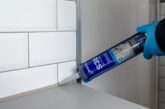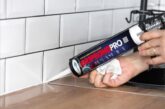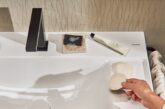
If you want to inhibit mould growth then reach for the One Bond silicone sealant range.
In the world of plumbing, addressing the challenges posed by mould growth is as crucial as fixing leaky pipes or installing fixtures securely. Mould poses health risks, looks unsightly and unhygienic, and will ruin the aesthetic finish of any kitchen or bathroom space. Ruling out leaks and damp problems is a vital step in combating mould issues, but plumbers can take proactive steps to minimise mould and educate homeowners on how to keep the spores at bay.
One simple yet effective solution to combat mould growth is the proper use of silicone sealants. However, it’s essential to understand the nuances of this preventive product to ensure its efficacy.
Mould growth is a persistent issue in areas exposed to moisture, in fact, spores can form in as little as 24 – 48 hours when the conditions are right. Black mould is commonly found in bedrooms, kitchens and bathrooms, particularly around windows on the window sealant. Silicone sealants, commonly used to create watertight seals around joints and fixtures, can become breeding grounds for mould if not properly managed.
Like grout, silicone sealants can harbour imperfections that trap dirt, soap fats and grease, which also encourages bacteria growth, and this is often called ‘pink mould’ despite it not actually being mould at all.
Before applying any grout or sealants, it is essential to ensure that the area and surfaces that the sealants will be applied to are clean, dry and dust free. Silicones are water-resistant when fully cured but cannot be applied to damp surfaces.
Bacteria is unable to penetrate the silicone bead due to its rubber-like and non-porous properties, however, plumbers should ensure that the sealant is correctly tooled and finished to create a smooth, void-free surface. This will significantly reduce the risk of bacteria and mould growth, by eliminating potential spaces for problems to occur.
As well as effective application, some silicone sealants on the market, including those in the OneBond range, have an extra trick up their sleeve – anti-mould additives.
Anti-mould additives
Anti-mould additives are substances incorporated into silicone sealants during manufacturing as an extra line of defence against mould. These additives inhibit mould growth both within and on the silicone material. OneBond silicone sealants have been tested according to UNE – EN ISO 846:1998 in strict laboratory settings to evaluate mould growth. The products obtained the best rating of 0, as no signs of mould growth were detectable under a microscope after four weeks of incubation.
While anti-mould additives provide a valuable layer of protection, their effectiveness is maximised when homeowners actively participate in maintaining a hygienic environment. Encouraging occupants to adopt a regular cleaning regime is crucial. By keeping the surface of silicone sealants clean and free from moisture-harbouring substances, homeowners can effectively curb mould growth.

Furthermore, adequate heating and ventilation is pivotal in preventing condensation – one of the prime contributors to the growth of mould. Adequate airflow from extractor fans and trickle vents maintains a drier environment, making it less conducive for mould spores to take root and flourish. The combined effort of anti-mould additives, proper finishing, regular cleaning and good heating and ventilation creates a robust defence against mould-related problems.
Sanitary sealant
OneBond’s Silicone Sanitary sealant is very easy to apply and tool, creating a better, cleaner finish around the likes of sinks, shower trays, bathtubs and ceramic tiling. The sealant is solvent-free to ensure zero shrinkage and prevents the development of leaks or gaps in which mould can grow. This sanitary sealant is also resistant to everyday cleaning products, meaning homeowners can implement an appropriate cleaning routine without detriment to the sealant itself.
For other applications, the manufacturer’s Multi-Purpose Silicone sealant is recommended for window frames, kitchen backsplashes and countertops, as this product features high resistance to bacteria and mould, which helps keep food preparation areas clean and hygienic.

The battle against mould growth is multi-faceted and requires the collaboration of both plumbing professionals and homeowners. Incorporating anti-mould additives in silicone sealants is a significant step towards preventing mould growth; however, this measure should be coupled with proper application techniques, regular cleaning, good heating and ventilation, and homeowner responsibility.
Understanding the limitations and benefits of silicone materials and anti-mould additives is essential for plumbers and homeowners alike. By debunking myths and embracing the truth about where mould can and cannot grow, the plumbing community can work together to create durable, hygienic and mould-resistant plumbing systems.
To learn more about the OneBond product range visit Product categories | Onebondadhesives.







